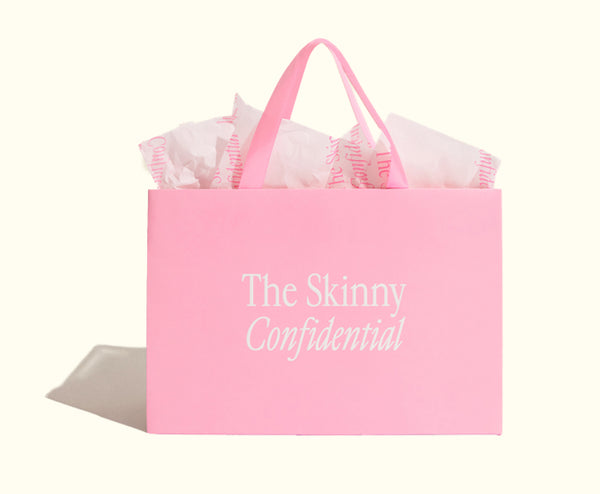
If you had to guess what the best beauty hack is, would your answer be sun protection? Believe it or not, that’s the right answer! At least here at The Skinny Confidential, it is. It prevents fine lines and wrinkles, keeps skin tone even, preserves skin elasticity, and, of course, reduces your risk of skin cancer. However, there are a lot of “sunscreens” and “sunblocks” out there. And, really, what’s the difference?
The terms sunscreen and sunblock are often used interchangeably, but the truth is they’re not the same. Knowing the difference may seem insignificant at first, but it really is key to protecting your skin effectively. So, we’re dedicating this post to the two types of sun protection and which is best for your beauty goals.
Here’s what you need to know:

What’s The Difference Between Sunscreen and Sunblock?
We’re so passionate about sun protection that founder of TSC, Lauryn Bosstick, literally wrote the book on it titled Get the F*ck Out of the Sun. She also launched a podcast by the same name, which you can check out here. The Skinny Confidential was one of the first beauty brands out there telling followers to stop tanning and start protecting. This, in turn, prompted us to launch our own TSC sunblock—full of all the best ingredients to upgrade your beauty routine and keep your skin clean and radiant.
So, we have a sunblock, but how is that different from sunscreen? It’s true that the terms are often used interchangeably in conversation and even in product names (ours is technically a sunblock, but we call it Caffeinated Sunscreen). However, there is a key difference between the two. Let’s get into it.
Is There A Difference Between Sunscreen and Sunblock?
Yes! The difference is in the way they block the sun. Both are effective, but one creates a physical barrier to block the sun while the other uses a chemical barrier to block UV rays. It may seem like there’s not much of a difference, but trust us, there is. Physical sunblock is often considered the safer, healthier option, as chemical sunscreens can contain potentially harmful ingredients that may be absorbed into the bloodstream over time.
What Is A Sunscreen?
Sunscreens (or chemical sunscreens) use chemical ingredients to absorb harmful UVA and UVB rays, protecting skin from sun damage. They’re lightweight and invisible on the skin, making them a really popular choice for sun protection. However, many products on the market contain toxic ingredients—including PFAS—that can irritate sensitive skin and increase long-term health issues. Ultraviolet (UV) light is damaging, but chemical sunscreens are, too!
What Are The Main Ingredients In Sunscreen?
-
Chemical UV Filters
-
Avobenzone
-
Oxybenzone
-
Octinoxate
-
Octisalate
-
Octocrylene
-
Homosalate
-
Ensulizole
-
Mexoryl SX
-
Mexoryl XL
-
Base & Texture Agents
-
Water
-
Dimethicone
-
Cyclopentasiloxane
-
Alcohol Denat.
-
Butylene Glycol
-
Caprylyl Glycol
-
Carbomer
-
Triethanolamine
-
Moisturizers & Conditioners
-
Glycerin
-
Aloe Vera Extract
-
Preservatives & Stabilizers
-
Phenoxyethanol
-
Ethylhexylglycerin
-
Antioxidant
-
Tocopherol (Vitamin E)
-
Green Tea Extract

How Does Sunscreen Work?
Step 1: Chemical sunscreen absorbs UV rays.
When you apply sunscreen, one of the chemical UV filters listed above sinks into the top layer of your skin. The ingredients then absorb the sun rays before they can penetrate deeper into your skin and cause damage. It takes about 15 minutes to fully absorb for full protection.
Step 2: The sunscreen converts the radiation to heat.
Once the rays are absorbed, it triggers a chemical reaction that turns the rays into heat. This is what actually neutralizes the UV radiation and protects your skin from sun damage.
Step 3: The heat is released from the skin.
Once the UV rays are turned into heat, that heat just gets released from your skin, usually without you even feeling it. After it’s absorbed and converted a certain amount of UV radiation, it starts to lose its effectiveness. Plus, things like swimming or sweating can wear it off faster, so you’ll need to reapply your sunscreen to stay protected. Water resistance adds extra protection, but you still don’t want to skip reapplication.
What Is A Sunblock?
Sunblock is a physical sunscreen. It creates a barrier on your skin that reflects and scatters sun rays instead of absorbing them. With sunblock, the UV radiation never even penetrates the skin. It also provides instant protection, unlike sunscreen. Since these don’t have harmful chemicals that enter the bloodstream, they’re better for your health, better for your skin, and better for your beauty goals.
What Are The Active Ingredients In Sunblock?
-
Active Ingredients (Mineral UV Filters)
-
Zinc Oxide
-
Titanium Dioxide
-
Base & Texture Agents
-
Water
-
Cetearyl Alcohol
-
Caprylic/Capric Triglyceride
-
Dimethicone
-
Cyclopentasiloxane
-
Lecithin
-
Sorbitan Stearate
-
Xanthan Gum
-
Carbomer
-
Moisturizers & Conditioners
-
Glycerin
-
Shea Butter
-
Aloe Vera
-
Niacinamide (Vitamin B3)
-
Preservatives & Stabilizers
-
Phenoxyethanol
-
Ethylhexylglycerin
-
Antioxidants
-
Tocopherol (Vitamin E)
-
Green Tea Extract
-
Optional Additives
-
Iron Oxides (in tinted versions)
How Does Sunblock Work?
Step 1: The mineral sunblock sits on the skin.
One of the mineral UV filters like zinc oxide or titanium dioxide creates a thin protective layer on the surface of the skin, creating an instant physical shield against those UV rays.
Step 2: Mineral sunblock reflects UV rays.
When the UV rays hit your skin, the minerals bounce the rays right off. That means that sunblock reflects the sun rays instead of letting them actually penetrate the skin.

Which Is Better Sunscreen Or Sunblock?
Physical sunscreen (AKA sunblock), like The Skinny Confidential Caffeinated Sunscreen, is always the better choice. Here’s why:
-
Works instantly—no wait time needed
-
Reflects and scatters UV rays instead of absorbing them
-
Gentler on sensitive and acne-prone skin
-
Fewer synthetic chemicals, so safer for your body
-
Safer for marine life and coral reefs
-
More stable, won’t break down quickly in the sun
-
Lower risk of hormone disruption
-
Safe for babies and young kids
-
Less likely to irritate or sting your eyes
It’s the obvious choice, right? The only downside is that sunblock sometimes leaves a white cast. However, many physical sunscreens like the TSC Caffeinated Sunscreen use iron oxide to slightly tint the sunscreen, so there’s no white cast and you get a bonus bronzy glow. (No tanning required.)
Other reasons to grab our sunscreen? The carefully chosen, safe ingredients (like caffeine) not only provide sun protection but also hydrate the skin, smooth fine lines and wrinkles, and help minimize puffiness. Plus, the American Academy of Dermatology recommends sun protection factor (SPF) 30 or higher, and The Skinny Confidential Caffeinated Sunscreen is SPF 40. It’s the best physical sunscreen out there for skincare aficionados like us.
Sunblock (physical sunscreen) is the best choice for your skin, your health, and your beauty goals.
Picking the right sun protection is honestly one of the easiest ways to keep your skin looking fresh and healthy. And, knowing the difference between sunscreen and sunblock helps you make smarter choices that protect your skin and keep you looking amazing. Sunblock (physical sunscreen) gets you strong, safe, and skin-loving protection that fits right into your daily routine.
Remember: the foundation of all skincare is good sun care, so make sure the right type of sunscreen is part of your morning skincare regimen. Also, don’t forget to reapply sunscreen or sunblock no matter what your day holds. You’d be surprised at how easy it is for the sun’s rays to sneak up on you.
For more non-toxic skincare products and must-have beauty tools, browse The Skinny Confidential Shop. And, if you want more advice on sunscreen/sunblock best practices, check out these posts:






